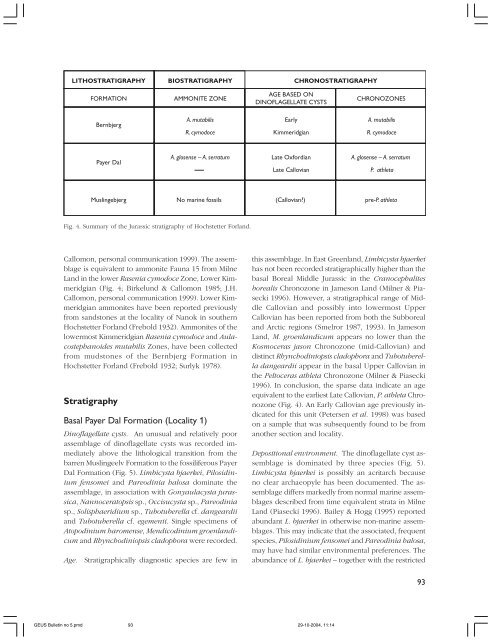GEUS Bulletin no 5.pmd
GEUS Bulletin no 5.pmd
GEUS Bulletin no 5.pmd
You also want an ePaper? Increase the reach of your titles
YUMPU automatically turns print PDFs into web optimized ePapers that Google loves.
LITHOSTRATIGRAPHY BIOSTRATIGRAPHY<br />
FORMATION AMMONITE ZONE<br />
Bernbjerg<br />
Payer Dal<br />
Callomon, personal communication 1999). The assemblage<br />
is equivalent to ammonite Fauna 15 from Milne<br />
Land in the lower Rasenia cymodoce Zone, Lower Kimmeridgian<br />
(Fig. 4; Birkelund & Callomon 1985; J.H.<br />
Callomon, personal communication 1999). Lower Kimmeridgian<br />
ammonites have been reported previously<br />
from sandstones at the locality of Na<strong>no</strong>k in southern<br />
Hochstetter Forland (Frebold 1932). Ammonites of the<br />
lowermost Kimmeridgian Rasenia cymodoce and Aulacostepha<strong>no</strong>ides<br />
mutabilis Zones, have been collected<br />
from mudstones of the Bernbjerg Formation in<br />
Hochstetter Forland (Frebold 1932; Surlyk 1978).<br />
Stratigraphy<br />
A. mutabilis<br />
R. cymodoce<br />
Basal Payer Dal Formation (Locality 1)<br />
Di<strong>no</strong>flagellate cysts. An unusual and relatively poor<br />
assemblage of di<strong>no</strong>flagellate cysts was recorded immediately<br />
above the lithological transition from the<br />
barren Muslingeelv Formation to the fossiliferous Payer<br />
Dal Formation (Fig. 5). Limbicysta bjaerkei, Pilosidinium<br />
fensomei and Pareodinia halosa dominate the<br />
assemblage, in association with Gonyaulacysta jurassica,<br />
Nan<strong>no</strong>ceratopsis sp., Occisucysta sp., Pareodinia<br />
sp., Solisphaeridium sp., Tubotuberella cf. dangeardii<br />
and Tubotuberella cf. egemenii. Single specimens of<br />
Atopodinium haromense, Mendicodinium groenlandicum<br />
and Rhynchodiniopsis cladophora were recorded.<br />
Age. Stratigraphically diag<strong>no</strong>stic species are few in<br />
AGE BASED ON<br />
DINOFLAGELLATE CYSTS<br />
Early<br />
Kimmeridgian<br />
CHRONOZONES<br />
A. mutabilis<br />
R. cymodoce<br />
A. glosense – A. serratum Late Oxfordian<br />
A. glosense – A. serratum<br />
Late Callovian P. athleta<br />
Muslingebjerg No marine fossils (Callovian?) pre-P. athleta<br />
Fig. 4. Summary of the Jurassic stratigraphy of Hochstetter Forland.<br />
<strong>GEUS</strong> <strong>Bulletin</strong> <strong>no</strong> <strong>5.pmd</strong> 93<br />
29-10-2004, 11:14<br />
CHRONOSTRATIGRAPHY<br />
this assemblage. In East Greenland, Limbicysta bjaerkei<br />
has <strong>no</strong>t been recorded stratigraphically higher than the<br />
basal Boreal Middle Jurassic in the Cra<strong>no</strong>cephalites<br />
borealis Chro<strong>no</strong>zone in Jameson Land (Milner & Piasecki<br />
1996). However, a stratigraphical range of Middle<br />
Callovian and possibly into lowermost Upper<br />
Callovian has been reported from both the Subboreal<br />
and Arctic regions (Smelror 1987, 1993). In Jameson<br />
Land, M. groenlandicum appears <strong>no</strong> lower than the<br />
Kosmoceras jason Chro<strong>no</strong>zone (mid-Callovian) and<br />
distinct Rhynchodiniopsis cladophora and Tubotuberella<br />
dangeardii appear in the basal Upper Callovian in<br />
the Peltoceras athleta Chro<strong>no</strong>zone (Milner & Piasecki<br />
1996). In conclusion, the sparse data indicate an age<br />
equivalent to the earliest Late Callovian, P. athleta Chro<strong>no</strong>zone<br />
(Fig. 4). An Early Callovian age previously indicated<br />
for this unit (Petersen et al. 1998) was based<br />
on a sample that was subsequently found to be from<br />
a<strong>no</strong>ther section and locality.<br />
Depositional environment. The di<strong>no</strong>flagellate cyst assemblage<br />
is dominated by three species (Fig. 5).<br />
Limbicysta bjaerkei is possibly an acritarch because<br />
<strong>no</strong> clear archaeopyle has been documented. The assemblage<br />
differs markedly from <strong>no</strong>rmal marine assemblages<br />
described from time equivalent strata in Milne<br />
Land (Piasecki 1996). Bailey & Hogg (1995) reported<br />
abundant L. bjaerkei in otherwise <strong>no</strong>n-marine assemblages.<br />
This may indicate that the associated, frequent<br />
species, Pilosidinium fensomei and Pareodinia halosa,<br />
may have had similar environmental preferences. The<br />
abundance of L. bjaerkei – together with the restricted<br />
93

















